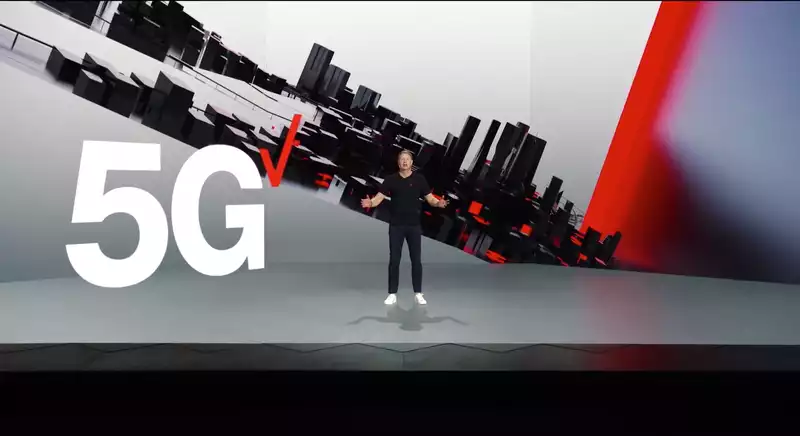Verizon touted the benefits of 5G in general and 5G networks in particular at CES 2021. But if you listened to CEO Hans Vestberg's presentation this week, you'd be forgiven for thinking you were watching a replay of his 2019 speech.
To be fair, at the time, Verizon had not even launched 5G wireless service for its customers. These days, Verizon's 5G is spreading across the country. But the essential message of Verizon's CES speech is the same then as it is now, with only a slight change in verb tense.
Smartphone owners who have experienced 5G will understandably feel like they've heard it before, with little concrete evidence that 5G will actually happen. It is true that Verizon's 5G network is capable of 4 Gbps under ideal conditions and 1 Gbps or faster if you are near Verizon's mmWave-based towers.
The problem is that these towers are currently only installed in a few of the 59 cities. Also, due to the nature of mmWave signals, these waves do not reach very far and do not penetrate physical obstacles such as walls and windows. - Typically, one must be in an outdoor location with a view of a radio tower in order to enjoy high-speed communications. Since the beginning of the coronavirus pandemic, most of us have taken refuge indoors, so we are unlikely to encounter mmWave towers.
Verizon launched nationwide 5G communications as soon as the iPhone 12 was released in the fall. Because it uses a different frequency band than millimeter wave, coverage is more extensive, but not as fast. In fact, in December, reports surfaced that some customers felt that 5G speeds using dynamic spectrum sharing technology were slower than LTE, at least in some locations.
As a result, some smartphone users may be wondering when they will be able to reap the benefits of 5G. at CES, Vestberg's answer is: "We're not sure. Very soon.
"5G is not our future, it is our present," Vestberg said, adding that the new network standard will "enable other innovations."
To that end, Vestberg described some of the advances that 5G is helping to facilitate. And in some cases, some of these benefits can be realized without the freedom to roam as freely as before.
For example, 5G's high speed and low latency offer opportunities to facilitate distance learning. Vestberg cites the example of a field trip to a museum that is now done virtually with the help of 5G.
Verizon is helping the Smithsonian Institution digitize its collection, creating 3D scans of exhibits that people can call up and explore at home. One example featured in Vestberg's CES keynote was the Apollo 11 command module, which appeared virtually on stage and was broken into parts so that curious students could see the different parts of the command module that helped humans land on the moon.
Verizon also partnered with the Metropolitan Museum of Art in New York City to offer a virtual exhibit of 50 artworks to anyone with a 4G or 5G device. Selected works will be augmented with augmented reality (AR) for those using 5G to further explore the Metropolitan Museum of Art's collection. The free exhibit will run for five weeks beginning today (January 12).
5G can also play a role in coordinating transportation, such as traffic management and package delivery in smart cities, Vestberg said. For the latter, Verizon is working with its drone subsidiary Skyward and UPS to support package delivery to homes by drone. While Verizon, Skyward, and UPS are testing drone delivery using LTE, low-latency 5G is considered a better way to manage fleets of drones carrying packages.
According to UPS, it has already completed more than 3,800 successful drone delivery flights, and both companies plan to enhance their delivery programs this year by using drones to deliver retail goods to customers in The Villages, Florida.
The other 5G benefits Vestberg described at CES will not be realized until people can leave their homes and go to crowded venues. In sports, Verizon continues to deploy high-speed 5G in stadiums and arenas; by 2021, Verizon plans to expand 5G coverage in 28 of the NFL's 30 stadiums, including in time for this year's Super Bowl at Tampa, Fla. including Raymond James Stadium in Tampa, Fla. The NFL app for mobile devices will also offer 5G Super Stadium functionality, allowing users to view the game from different camera angles and create video overlays featuring players and current statistics.
Verizon believes that 5G will bring similar benefits to live music. Verizon has outfitted the Wiltern Theater in Los Angeles as a 5G venue, allowing people with compatible devices to view the show from multiple angles, including camera views from the stage. Verizon plans to offer such an experience at a total of 15 venues owned by concert promoter LiveNations.
If you purchased a 5G phone last year and have been overwhelmed by the speeds so far, these advances may not mean much. However, they are a reminder that 5G continues to evolve and could bring benefits we are only beginning to understand.
.









Comments